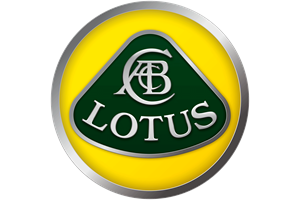A brief history of
Lotus
Introduction
The car manufacturer Lotus has made an important impact on the automotive world. In this article we will give a brief but detailed history of the Lotus marque.
We will look at the origins of Lotus looking at who, why, where and when Lotus was founded. We'll look at the design of the iconic Lotus logo and what are some the more significant Lotus models.
We'll take a glance at what racing history the Lotus has and who some of the most important people have been in the history of Lotus over the years.
Who, where, when and why was
Lotus founded?
Lotus Cars, a British sports car manufacturer, was founded by Colin Chapman in 1952. Chapman, an accomplished engineer and racing enthusiast, established the company with the vision of creating lightweight, high-performance sports cars that would excel on both the road and the race track. With its headquarters based in Hethel, Norfolk, England, Lotus became synonymous with innovation, precision engineering, and a relentless pursuit of speed.
Colin Chapman's motivation for founding Lotus stemmed from his passion for motorsports and his desire to challenge the status quo in the automotive industry. He believed that by applying advanced engineering principles and embracing cutting-edge technologies, he could create cars that would outperform their competitors. Lotus quickly gained a reputation for its groundbreaking designs and unconventional approach to automotive engineering.
The location of Lotus' headquarters in Hethel was not a coincidence. The site offered ample space for testing and development, including its own private test track. This allowed Lotus to fine-tune its cars and push them to their limits, ensuring that every vehicle delivered the exceptional performance and handling expected from the brand.
Lotus' success in motorsports further solidified its reputation. The company's involvement in Formula 1 racing brought numerous victories and championship titles, including legendary wins with drivers like Jim Clark and Ayrton Senna. The racing success of Lotus cars showcased their exceptional performance capabilities and further elevated the brand's status in the automotive world.
Throughout its history, Lotus has remained committed to its founding principles of lightweight construction, aerodynamic design, and agile handling. The company's iconic models, such as the Lotus Elise, Exige, and Evora, have continued to embody these principles, delivering thrilling driving experiences and setting new benchmarks for performance in their respective segments.
Today, Lotus continues to innovate and push the boundaries of automotive engineering. Under new ownership and with significant investment, the brand is set to introduce a new era of Lotus cars that embrace electric powertrains while staying true to the company's heritage of performance and driving pleasure.
How did the
Lotus logo originate?

How did the Lotus logo originate?
The Lotus logo has undergone several iterations throughout the company's history, each reflecting the brand's identity and evolution. The original Lotus logo featured the letters "ACBC" in a circle, representing the initials of the company's founder, Anthony Colin Bruce Chapman. This logo was used in the early years of Lotus, symbolizing Chapman's personal connection to the brand and his commitment to pushing the boundaries of automotive engineering.
In the 1960s, Lotus introduced a new logo that would become synonymous with the brand. The iconic Lotus roundel featured a green and yellow color scheme, with a stylized lotus flower in the center and the brand name encircling it. The lotus flower, a symbol of purity and beauty, perfectly captured the essence of Lotus cars and the brand's commitment to creating exceptional sports cars. The green and yellow color scheme became instantly recognizable and was often associated with the brand's racing success.
In the following decades, the Lotus logo underwent some refinements but retained the core elements of the lotus flower and the brand name. The logo evolved to adopt a more modern and streamlined design, reflecting the brand's forward-thinking approach and commitment to innovation. The colors remained consistent, with green representing the brand's racing heritage and yellow symbolizing its energy and enthusiasm.
In recent years, Lotus introduced a refreshed logo to coincide with the brand's new chapter under new ownership. The current logo maintains the lotus flower as its centerpiece but features a more minimalist and contemporary design. It represents a new era for Lotus, combining its rich heritage with a vision for the future.
The Lotus logo has always been an important visual representation of the brand's values, history, and aspirations. It has become an emblem of performance, engineering excellence, and the thrill of driving a Lotus car.
What are some of the significant
Lotus models?
Lotus has a rich history of producing high-performance sports cars that have captivated enthusiasts around the world. From the early years to the present day, the brand has consistently pushed the boundaries of automotive engineering and delivered thrilling driving experiences. Let's explore some of Lotus' most significant models, with a focus on the higher performance offerings.
In the 1950s and 1960s, Lotus introduced iconic models that laid the foundation for its reputation as a manufacturer of lightweight, agile, and race-bred cars. The Lotus Eleven, introduced in 1956, was a purpose-built track car that showcased the brand's commitment to aerodynamics and performance. Its sleek design, low weight, and powerful engine made it a formidable competitor in motorsport events. Another notable model from this era is the Lotus Elan, introduced in 1962. The Elan epitomized Lotus' ethos of performance and handling. Its lightweight construction, advanced suspension setup, and responsive engine made it a thrilling road car and a success on the racetrack.
In the 1970s and 1980s, Lotus continued to push boundaries with its high-performance offerings. One standout model from this period is the Lotus Esprit. Introduced in 1976, the Esprit showcased the brand's commitment to avant-garde design and performance. With its wedge-shaped body, mid-engine layout, and turbocharged engines, the Esprit offered impressive acceleration and handling. The Esprit gained further prominence when it starred in the James Bond film "The Spy Who Loved Me," solidifying its status as an icon of automotive design and performance.
Entering the 1990s and early 2000s, Lotus introduced the Elise, a lightweight and nimble sports car that became an instant hit. The Elise embodied Lotus' philosophy of performance through lightweight engineering. Its minimalist design, bonded aluminum chassis, and responsive handling made it a favorite among driving enthusiasts. The Elise was also the foundation for other performance models like the Exige, which added increased power and aerodynamic enhancements to deliver even greater performance on the track.
In more recent years, Lotus has continued to expand its lineup of high-performance models. The Evora, introduced in 2009, combines luxury and performance in a stylish package. With its powerful engines, advanced aerodynamics, and refined interiors, the Evora has further solidified Lotus' reputation as a manufacturer of premium sports cars. Additionally, Lotus has unveiled the Evija, an all-electric hypercar that represents the brand's vision for the future of high-performance vehicles. With its exceptional power, cutting-edge technology, and striking design, the Evija is set to redefine the boundaries of performance.
Throughout its history, Lotus has consistently delivered extraordinary performance cars that offer exhilarating driving experiences. From the early track-focused models to the modern, technologically advanced offerings, Lotus has remained committed to its core principles of lightweight construction, precise handling, and unmatched driving dynamics. Each model represents a testament to Lotus' dedication to pushing the boundaries of what is possible in the automotive world.

One of Lotus's Most Iconic Models
Who are some of the most important people in
Lotus's History
Behind the success and innovation of Lotus are several significant individuals who have played instrumental roles in shaping the brand's identity and pushing the boundaries of automotive engineering. These individuals have contributed their expertise, vision, and passion to make Lotus the iconic manufacturer it is today.
One of the key figures in Lotus' history is Colin Chapman, the founder of the company. Chapman's relentless pursuit of lightweight construction and innovative engineering solutions became the foundation of Lotus' philosophy. His revolutionary designs and unconventional approaches revolutionized the automotive industry. Chapman's visionary mindset led to the creation of groundbreaking models like the Lotus Seven and Lotus Elite, which set new standards for performance and handling.
In addition to Chapman, another notable individual who made a significant impact on Lotus is Peter Stevens. Stevens, an accomplished automotive designer, was responsible for penning the iconic shape of the Lotus Esprit. His timeless design transformed the Esprit into a symbol of automotive excellence and elegance. Stevens' contribution to Lotus' design language extended beyond the Esprit, as he also played a role in shaping the aesthetics of other Lotus models, including the Elan and the Elise. His keen eye for aerodynamics and aesthetics helped define the visual identity of Lotus cars.
Another influential figure in Lotus' history is Mike Kimberley, who served as the CEO of Lotus from 1991 to 2009. Kimberley played a pivotal role in steering the company through challenging times and ensuring its long-term success. Under his leadership, Lotus expanded its product lineup, introduced new technologies, and strengthened its position as a manufacturer of high-performance sports cars. Kimberley's strategic decisions and commitment to excellence helped secure Lotus' place among the top automotive brands in the world.
Furthermore, the contributions of individuals like Gordon Murray and Matt Windle cannot be overlooked. Murray, a renowned automotive designer and engineer, collaborated with Lotus on the development of the Lotus Carlton, a high-performance sedan that pushed the boundaries of what was possible in a four-door car. Windle, the current Managing Director of Lotus Cars, has been instrumental in driving the brand's modernization and product development efforts. Under his leadership, Lotus has introduced new models like the Evija and Evora GT, solidifying the brand's position as a leader in the high-performance segment.
These individuals, along with countless engineers, designers, and enthusiasts, have played pivotal roles in shaping Lotus' identity and cementing its position as a manufacturer of exceptional sports cars. Their dedication, expertise, and unwavering commitment to innovation have propelled Lotus to the forefront of the automotive industry, inspiring generations of car enthusiasts and setting new benchmarks for performance, handling, and driving pleasure.

One of the most influential people in the history of Lotus
Lotus's Racing History
Lotus has a rich and storied racing history that spans several decades. The brand's commitment to motorsport has not only showcased its engineering prowess but also served as a testing ground for innovation and technological advancements. Lotus cars have made their mark in various racing disciplines, leaving a lasting legacy in the world of motorsport.
One of the most iconic moments in Lotus' racing history came in the 1960s with the introduction of the Lotus 25 Formula 1 car. Designed by Colin Chapman, the Lotus 25 revolutionized the sport with its monocoque chassis and rear-engine layout. The car brought significant success to Lotus, winning multiple Formula 1 championships. Drivers like Jim Clark and Graham Hill piloted the Lotus 25 to victories, solidifying the brand's presence in the pinnacle of motorsport.
Lotus' success in Formula 1 continued into the 1970s with the introduction of the Lotus 72. This ground-breaking car featured advancements in aerodynamics and suspension, allowing it to dominate the championship. The Lotus 72 secured two World Championships for Lotus and added to the brand's legacy of innovation and performance.
Throughout the years, Lotus has also been involved in other racing disciplines, including endurance racing. The Lotus Eleven, introduced in the 1950s, was a successful sports car that achieved numerous victories in endurance races such as the 24 Hours of Le Mans and the 12 Hours of Sebring. The car's lightweight construction and agile handling made it a formidable competitor on the track.
Lotus' commitment to racing extended beyond Formula 1 and endurance racing. The brand has also participated in various other series, including touring car championships. The Lotus Cortina, a collaboration between Lotus and Ford, achieved success in the British Touring Car Championship, securing multiple wins and championships.
In recent years, Lotus has continued its racing endeavors with the introduction of the Evora GT4 and Evora GT430. These track-focused cars have competed in championships such as the GT World Challenge and have showcased the performance capabilities of Lotus' latest offerings.
Lotus' racing heritage is a testament to the brand's dedication to performance and competition. The success achieved on the racetrack has not only solidified Lotus' reputation as a manufacturer of high-performance cars but has also served as a platform for technological advancements that benefit their road cars. Whether in Formula 1, endurance racing, or touring car championships, Lotus' presence in motorsport has left an indelible mark on the racing world and has been an integral part of the brand's identity.
Summary
Lotus is a car manufacturer with a rich racing heritage and a commitment to engineering excellence. From its early days in Formula 1 to its success in endurance racing and touring car championships, Lotus has left an enduring mark on the world of motorsport. The brand's innovative designs, lightweight constructions, and agile handling have made its cars formidable competitors on the track.
Lotus' racing history is filled with iconic moments and legendary models. The introduction of the Lotus 25 and Lotus 72 in Formula 1 showcased the brand's ability to push the boundaries of engineering and aerodynamics. The success of these cars, driven by renowned drivers like Jim Clark and Graham Hill, solidified Lotus' position as a force to be reckoned with in the sport.
Furthermore, Lotus' involvement in endurance racing with cars like the Lotus Eleven demonstrated its ability to create competitive and reliable vehicles. The brand's foray into touring car championships with the Lotus Cortina added to its racing legacy. In recent years, Lotus has continued to innovate and compete with track-focused models like the Evora GT4 and Evora GT430.
Overall, Lotus' racing heritage is a testament to its pursuit of performance, innovation, and success on the track. The brand's commitment to motorsport has not only shaped its reputation but has also contributed to advancements in automotive technology. Lotus' racing DNA is ingrained in its road cars, making them thrilling and exhilarating to drive. With its rich racing history and continued dedication to performance, Lotus remains a respected and admired name in the world of motorsport.
View Lotus Car Specifications
More Manufacturer Histories.

























